Mercury Grand Marquis
| Mercury Grand Marquis | |
|---|---|
 | |
| Overview | |
| Manufacturer | Mercury |
| Model years | 1975–2011 |
| Body and chassis | |
| Class | Full-size sedan |
| Layout | FR layout, Body-on-frame |
| Platform | Ford Panther platform |
| Related |
Lincoln Town Car Ford Crown Victoria Ford LTD Crown Victoria |
| Chronology | |
| Predecessor | Mercury Marquis |
The Mercury Grand Marquis is a full-size rear-wheel drive luxury sedan that was sold by Mercury from 1975 to 2011. From 1975 to 1982, it was the premium model of the Mercury Marquis model line and became a standalone model in 1983. For its entire production run, the Grand Marquis served as the flagship of the Mercury line; it was the Mercury counterpart of the Ford (LTD) Crown Victoria. From 1979 to 2011, it shared the Panther platform along with the Lincoln Town Car.
From 1979 to 1985, the Grand Marquis was manufactured at the St. Louis Assembly Plant in Hazelwood, Missouri. From 1986 to 2011, production was located at the St. Thomas Assembly Plant in Southwold, Ontario, Canada. With the phasing out of the Mercury brand following the 2010 model year, a limited run of 2011 models were produced. The last Grand Marquis rolled off the assembly line on January 4, 2011;[1] it was the final Mercury vehicle produced.
1975–1978
| 1975-1978 | |
|---|---|
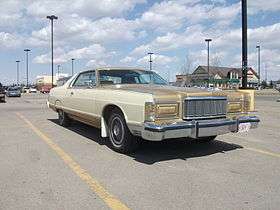 1975–1978 Mercury Grand Marquis 2-door | |
| Overview | |
| Model years | 1975–1978 |
| Assembly |
Hazelwood, Missouri (St. Louis Assembly Plant) Pico Rivera, California (Los Angeles Assembly) Hapeville, Georgia (Atlanta Assembly) |
| Body and chassis | |
| Class | Full-size car |
| Body style |
2-door hardtop (1975-1978) 2-door sedan (1979-1982) 4-door pillared hardtop (1975-1978) 4-door sedan (1979-1982) 5-door station wagon (1979-1982) |
| Layout | FR layout (body on frame) |
| Platform |
Full-size Ford (1975–1978) Ford Panther platform (1979–1982) |
| Chronology | |
| Predecessor | Mercury Marquis |
| Successor | Mercury Grand Marquis (1983–1991) |
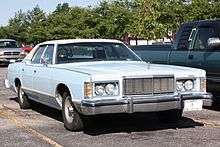
In 1967, the Marquis nameplate made its first appearance as a two-door hardtop version of the Mercury Monterey; largely the Mercury equivalent of the Ford LTD, the Marquis would serve the replacement for the Park Lane and Montclair as the Monterey became the entry model of the full-size Mercury line in 1969. In 1969, the Marquis would take over the Brougham trim package from the Park Lane.
In 1975, Mercury introduced the Grand Marquis as a higher-trim submodel of the Marquis.[2] Along with bridging the gap between the Mercury Marquis and the Lincoln Continental, the Grand Marquis allowed Mercury to more directly compete against the Buick Electra 225, Oldsmobile Ninety Eight, and the Chrysler New Yorker.
In 1979, as the Marquis was redesigned and downsized, the Grand Marquis made its return as the top-trim of the full-size Mercury line, its Ford counterpart was the newly introduced Ford LTD Crown Victoria.
First generation (1979–1991)
| First generation | |
|---|---|
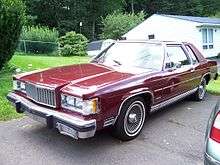 1983 Mercury Grand Marquis LS coupe | |
|
Front seats and interior, 1985, Mercury Grand Marquis LS | |
| Overview | |
| Also called |
Ford Conquistador (Venezuela, 1984–1989) Ford Grand Marquis (Mexico) |
| Model years |
1979–1991 987,818 produced |
| Assembly |
Canada: St. Thomas, Ontario (St. Thomas Assembly) United States: Hazelwood, Missouri (St. Louis Assembly Plant) Venezuela: Barcelona, Anzoátegui (División Industrial Automotriz) Mexico: Cuahutitlan Assembly |
| Body and chassis | |
| Body style |
2-door sedan 4-door sedan 5-door station wagon |
| Related |
Mercury Colony Park Ford LTD Crown Victoria Ford Country Squire Lincoln Town Car |
| Powertrain | |
| Engine |
4.9 L (302 cu in) 5.0 Windsor V8(1983–1991) 5.8 L (351 cu in) Windsor V8 (1986–1991) |
| Transmission | 4-speed AOD automatic |
| Dimensions | |
| Wheelbase | 114.3 in (2,903 mm) |
| Length | 210.3 in (5,342 mm) |
| Width | 77.5 in (1,968 mm) |
The Grand Marquis was introduced as a model in its own right in 1983, as Ford Motor Company split up its full-size and mid-size model lines for both Ford and Lincoln-Mercury. For Mercury, the Marquis nameplate became its entry on the mid-size Fox platform, replacing the sedan and wagon versions of the Cougar (as that car reverted to its traditional role as personal-luxury coupe); the similar Zephyr was replaced by the all-new front-wheel drive Topaz. Remaining the flagship sedan of the Mercury lineup, the Grand Marquis now was left as the sole full-size sedan of the division (for the first time since 1951).
Based upon the Panther platform, the Grand Marquis was the counterpart of the Ford LTD Crown Victoria, and the Lincoln Continental Mark VI. As with its Ford counterpart, a padded vinyl half-roof was standard equipment. While the LTD Crown Victoria was distinguished by a "crowning" metal band surrounding the B-pillars, which was first introduced in 1955 on the Crown Victoria, the Grand Marquis had opera lamps similar to the Lincoln Town Car; higher-trim versions also had the option of a "frenched" rear window. The Grand Marquis was available in two-door sedan and four-door sedan body styles in standard and LS trim (replacing Brougham, which became part of the mid-size Marquis line). As part of the model shift, the Colony Park station wagon became part of the Grand Marquis line; a non-woodgrain Grand Marquis was available as well (for 1983 only). Most versions of the Colony Park would wear Grand Marquis LS badging and trim.
Year-by-year changes
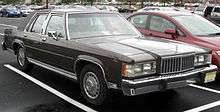
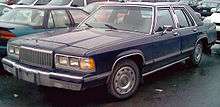
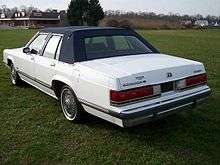
- 1983: Grand Marquis becomes a stand-alone model and sole full-size Mercury sedan. 5.0L V8 gains fuel injection. Minor revisions include a new grille, taillights, steering wheel, and interior trim changes.[3]
- 1984: Non-woodgrain Grand Marquis wagon discontinued, leaving Colony Park as only full-size Mercury wagon. Ford breaks even on its investment on the Panther redesign during the model year; each Grand Marquis is now sold at a profit.[3]
- 1985: To make room for the Ford Aerostar, production shifted from St. Louis to St. Thomas Assembly in Canada. Gas-charged shocks become standard, with rear air suspension as a newly available option.
As part of the change in production, several revisions were made. The horn is moved to the steering wheel, the dash is refitted for a single-DIN radio (conversely, the 8-track player and CB Radio are removed from the option list), and as they were standard features, the "Electronic Fuel Injection" and "Automatic Overdrive" emblems were deleted.[3]
- 1986: Introduced as a running change late in the 1985 model year, a CHMSL/third brake light was added to all versions of the Grand Marquis (and all American-market cars). Multi-port fuel injection is introduced on the 5.0 L engines to replace the older throttle body injection systems.
- 1987: The dash received updated trim; on the instrument panel, the "Check Oil" warning light is replaced by a "Check Engine" light.[3] This is the final year for Grand Marquis two-doors, with 4,904 produced.[4]
- 1988: Mid-cycle redesign for the Grand Marquis. All sheetmetal forward of the windshield and from the rear window to the back bumper is revised, with softer lines for (slightly) improved aerodynamics. New badging brought the Grand Marquis closer in line with the rest of the Mercury lineup. In place of serif-style script, block lettering (in the style of the Sable and Topaz) made its appearance on the trunklid. The Mercury "flying M" badge made its appearance for the first time on the Grand Marquis. The interior received enlarged head restraints with a tilt feature, and a refresh of the dash, as one wood trim piece, along with the instrument cluster itself being revised.
In line with the rest of the Mercury lineup, the base-trim model was rebadged GS alongside the top-trim LS. LS versions received options such as a JBL Audio 6-speaker AM/FM/Cassette stereo system with a power antenna. Other LS options included rear air suspension, vinyl top with a "frenched" rear window, Taller Front Head Rests and a heated windshield called "Instaclear".
- 1989: Largely carryover from 1988, with the instrument panel receiving a "Check Engine" light on all models.[3]
- 1990: Several revisions were made to improve safety features.[5] On all models, a drivers' side airbag was added, necessitating a redesign of the dashboard (and the deletion of the dashboard-mounted stereo speakers). Now shared with the LTD Crown Victoria, the instrument panel of the Grand Marquis traded its Lincoln-style square dials for a horizontal strip-style speedometer. Redesigned front seats were given downsized head restraints, while outboard passengers on the rear seat were given three-point seatbelts. Taller Head Rests were discontinued for smaller ones across both the LS and GS models.
- 1991: Last year for the first-generation Grand Marquis; redesigned 1992 model in early 1991. Final Grand Marquis produced with the 5.0L and 5.8L engines, and the final Colony Park wagons (3,104 produced).[4]
Powertrain

The 5.0L (302 cu in) 5.0 Windsor V8 was the sole engine available from model years 1983–1985. In 1986, the engine was converted from throttle-body to sequential multi-port fuel injection. These engines are easily distinguished by their cast aluminum upper intake manifolds with horizontal throttle body (vertical throttle plate); this replaced the traditional throttle body with a carburetor-style top-mounted air cleaner previously used. Additionally in 1986, the 5.8L Windsor V8 was returned to the Grand Marquis/Colony Park engine lineup. By the end of production in 1991, versions ordered with the 5.8L would be the final carbureted vehicles ever sold in North America by Ford.
Both engines were coupled to the four-speed AOD overdrive automatic transmission.
| Engine Name | Years Available | Configuration | Horsepower | Torque | Transmission |
|---|---|---|---|---|---|
| Ford 5.0 Windsor V8 | 1983–1991 | 4.9 L (302 cu in) OHV V8 | Ford AOD 4-speed overdrive automatic | ||
| Ford Windsor V8[10] | 1986–1991 | 5.8 L (351 cu in) OHV V8 | 180 hp (134 kW; 182 PS) | 285 lb·ft (386 N·m) |
Livery use
Limousine manufacturers used the Mercury Grand Marquis as a cheaper alternative to the mechanically similar Lincoln Town Car. These were more popular in Latin America than in the United States. In the 1989 James Bond movie Licence to Kill, the villain Franz Sanchez drives a black 1985 Grand Marquis Limousine. This limousine was black with a red interior.
| Year | 1983 | 1984 | 1985 | 1986 | 1987 | 1988 | 1989 | 1990 | 1991 | Total production |
|---|---|---|---|---|---|---|---|---|---|---|
| Units | 95,718 | 131,396 | 147,139 | 98,929 | 120,503 | 111,611 | 130,248 | 72,945 | 79,329 | 987,818 |
Second generation (1992–1997)
| Second generation | |
|---|---|
 1994 Grand Marquis LS | |
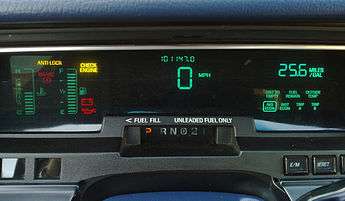 Digital instrument panel option (1992–2004) | |
| Overview | |
| Also called | Ford Grand Marquis (Mexico) |
| Model years | 1992–1997 |
| Assembly | Canada: St. Thomas, Ontario (St. Thomas Assembly) |
| Body and chassis | |
| Body style | 4-door sedan |
| Related |
Ford Crown Victoria Ford Police Interceptor Lincoln Town Car |
| Powertrain | |
| Engine | 4.6 L Modular V8 |
| Transmission |
4-speed AOD automatic 4-speed AOD-E automatic 4-speed 4R70W automatic |
| Dimensions | |
| Wheelbase | 114.4 in (2,906 mm) |
| Length |
212.4 in (5,395 mm) (1992–94) 211.8 in (5,380 mm) (1995–97) |
| Width |
77.8 in (1,976 mm) (1992–94) 78.0 in (1,981 mm) (1995–97) |
| Height | 56.8 in (1,443 mm) |
For the 1992 model year, both Ford and Mercury Panther-platform cars underwent their most extensive changes since their 1979 introduction. While the chassis was retained, the body was all-new from the ground up. After thirteen years on the market, the full-size sedans from Mercury and Ford were struggling against far more modern competition. Additionally, as unintentional consequence of over 30 years of badge engineering, the Grand Marquis and its LTD Crown Victoria counterpart were left as virtual identical twins. In a significant break from precedent, the Grand Marquis and Ford Crown Victoria (no longer an LTD model) were allowed completely different bodies; the only visually shared body parts were the front doors and the windshield.
In line with the rest of Ford Motor Company vehicles sold in North America, aerodynamics and fuel economy played a large role in the design of the new Grand Marquis. Unlike the Crown Victoria, which followed the design themes of the Ford Taurus, the Grand Marquis would combine contemporary design with traditional styling features seen in full-size sedans such as full-width taillights, a formal roofline, and a chrome waterfall grille. In various forms, the latter would become a signature styling feature across the Mercury product line from the late 1990s onward.
As part of the redesign, Ford sought a new type of buyer for its full-size Mercury sedan; instead of the older buyers who traditionally bought them, the 1992 Grand Marquis was marketed to younger buyers in need of a larger car than a Ford Taurus/Mercury Sable.[11] As such, the opera lamps and padded vinyl top were discontinued (the latter becoming a dealer-installed option); the imitation wire wheel covers were replaced by aluminum alloy wheels. Revisions to the suspension and steering were made to improve both ride and handling.[11] To improve stopping, four-wheel disc brakes replaced the rear drum brakes, with optional ABS; traction control was available as an option.
As with the 1988-1991 models, the Grand Marquis was available in base-trim GS and deluxe-trim LS models; LS models are distinguished by front cornering lamps. From 1992 onward, the Grand Marquis was produced solely as a four-door sedan, as the Colony Park station wagon was discontinued. Ford's Keyless Entry System became optional on lower trim packages, and standard on upper trim packages.
Year-to-year changes
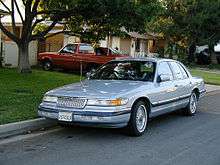
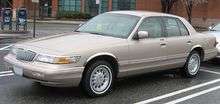
- 1992: Second-generation Grand Marquis introduced in the spring of 1991 as an early 1992 model.[11] All models come with drivers'-side airbag standard with an optional airbag.
- 1993: Dual airbags become standard equipment on all models. Radios are redesigned with a new control layout.
- 1994: Increased side door impact protection. A/C refrigerant changed from R-12 to R-134a.
- 1995: Mid-cycle redesign. Exterior trim features increased use of body-color trim and less chrome. On the front, a larger, rounder grille is better integrated to the body, while all lights on the front are changed to clear lenses. The license plate is now centered in between the taillamps. On the trunklid, the Mercury and Grand Marquis lettering is italicized and reduced in size.
Inside, much of the interior receives an update, with new seats, door panels, and the entire dashboard is redesigned with attention paid to ergonomics. Switching locations with the climate controls, a Double-DIN radio featured large buttons and knobs; on models without automatic climate controls, rotary knobs replaced sliding controls. The power seat controls, if specified, were now located on the door panels along with enlarged buttons for the power windows and door locks. The outdated horizontal speedometer was replaced by instrument cluster used in the Crown Victoria (adding a voltmeter and oil-pressure gauge); a digital instrument panel with trip computer was still an option.
- 1996: No major changes. Inside, the Ford "brick" airbag wheel in use since 1990 was replaced with a new design shared with many Ford and Lincoln-Mercury cars, integrating the horn into a smaller steering wheel hub.
- 1997: Last year for the second-generation Grand Marquis. The Mercury emblems are removed from the C-pillars. Following the discontinuation of the Chevrolet Caprice and Buick Roadmaster by General Motors, 1997 Grand Marquis sales would rise over 20% in comparison to 1996.
Powertrain
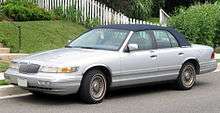
While the Panther platform was carried over from 1991, an all-new engine would be used for the 1992 Grand Marquis. The replacement for the OHV 5.0L and 5.8L Windsor V8s, the 4.6L SOHC Modular V8 engine was the first (and as of 2014, the only) overhead-cam V8 to appear in an American-market full-size sedan. Producing 190 hp, it was more powerful and more fuel-efficient than either of its predecessors. An optional handling package, including a heavy-duty suspension, 3.27 rear-axle (instead of 2.73), and a dual-exhaust system that raised engine output to 210 hp was an option; it was largely the counterpart to the Ford Crown Victoria Touring Sedan.
All models of the Grand Marquis were coupled to a 4-speed automatic transmission. For 1993, the hydraulically controlled AOD transmission was replaced by the electronically controlled AOD-E transmission.[5] In 1995, the AOD-E was replaced the heavier-duty 4R70W transmission;[5] it was shared with the Lincoln Mark VII and Town Car.
| Engine Name | Years Available | Configuration | Horsepower | Torque | Transmission |
|---|---|---|---|---|---|
| Ford Modular V8 | 1992-1997 | 4.6 L (281 cu in) SOHC 16-valve V8 |
|
|
Ford AOD 4-speed overdrive automatic (1992)
Ford AOD-E 4-speed overdrive automatic (1993-1994) Ford 4R70W 4-speed overdrive automatic (1995-1997) |
Production
While the redesigned 1992 Grand Marquis/Crown Victoria would prove more fuel efficient than their predecessors, a loophole in CAFE regulations allowed Ford Motor Company to sell both full-size cars and improve the average economy of all of its cars. CAFE regulations require vehicles with fewer than 75% domestic parts content to be counted as part of an automaker's imported fleet rather than a domestic one. During the 1991 retooling for production of 1992 models at its St. Thomas, Ontario facility, Ford switched a number of its parts suppliers from Canada and the United States to suppliers outside North America, bringing the domestic parts content of the Grand Marquis and Crown Victoria below 75%.[12] As such, the Grand Marquis was now part of a fleet consisting primarily of the far more fuel-efficient Ford Festiva rather than other V8-engined cars such as the Cougar and Ford Mustang.
| Year | 1992 | 1993 | 1994 | 1995 | 1996 | 1997 | Total production |
|---|---|---|---|---|---|---|---|
| Units | 163,262 | 90,367 | 107,894 | 94,202 | 104,433 | 127,949 | 688,107 |
Third generation (1998–2002)
| Third generation | |
|---|---|
 | |
| Overview | |
| Also called | Ford Grand Marquis (Mexico) |
| Model years | 1998–2002 |
| Assembly | Canada: St. Thomas, Ontario (St. Thomas Assembly) |
| Body and chassis | |
| Body style | 4-door sedan |
| Related |
Ford Crown Victoria Ford Police Interceptor Lincoln Town Car |
| Powertrain | |
| Engine | 4.6 L Modular V8 |
| Transmission | 4-speed 4R70W automatic |
| Dimensions | |
| Wheelbase | 114.7 in (2,913 mm) |
| Length | 211.9 in (5,382 mm) |
| Width | 78.2 in (1,986 mm) |
| Height | 56.8 in (1,443 mm) |
The Mercury Grand Marquis saw an extensive update for the 1998 model year. Although it bore a strong resemblance to the successful "Aero" style of the 1992-1997 model, only the roof and the doors were identical between them. The front and rear fascia were redesigned, with a new grille, hood, bumpers, headlamps/taillamps, and side mirrors.[5] The interior carried over from the 1995 update, with Ford's new two-spoke steering wheel replacing the previous four-spoke design.
Although less controversial than the 1991 redesign of its competitor Chevrolet Caprice, the 1992-1997 Crown Victoria's futuristic exterior design was not as well-received by car buyers as the Ford Taurus - the car that inspired it - had been. This enthusiasm gap helped the more traditional-looking Grand Marquis to outsell its Ford counterpart in 1994 and 1997. Ford softened the Crown Victoria's looks for 1998, adopting the more formal roofline of the Grand Marquis. Though virtual twins down to the chassis, both vehicles would use different front and rear fascias for the rest of their production.
Following the discontinuation of the Buick Roadmaster and Chevrolet Caprice after the 1996 model year, the Grand Marquis no longer received direct competition from General Motors. With the Crown Victoria as the only other full-size-sedan sold in North America with both rear-wheel drive and a V8 engine in its price range, Ford was left a highly profitable market niche essentially to itself.[14] Ford sold approximately 100,000 third generation Grand Marquis per year.
Mechanical details
.jpg)
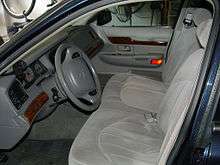
A fail-safe cooling system with a dual speed electric fan was put in place, along with a coil-on-plug ignition system. Larger dual piston brake calipers were added to the front, requiring 16 inch wheels to be standard.[5] A Watt's linkage was added to the rear suspension. Fuel lines were moved to the passenger side frame rail. A coded ignition key (known as Passive Anti-Theft System, or "PATS") system was introduced and a 72 amp/hour battery replaced the previous 58. Other minor changes included a redesigned engine cover and the power steering fluid reservoir being moved to the front of the engine.[5]
For 1998 to 2000, the 4.6 L SOHC V8 single exhaust had 200 hp with a 2.73 rear axle ratio. The 4.6 L SOHC V8 dual exhaust had 215 hp and came with a 3.27 or 3:55 rear axle ratio and handling suspension.
For 2001 to 2002, the 4.6 L SOHC V8 single exhaust had 220 hp with a 2.73 rear axle ratio. The 4.6 L SOHC V8 dual exhaust had 235 hp and came with a 3.27 or 3:55 rear axle ratio and handling suspension.
Introduced in the Spring of 2001, the Grand Marquis LSE had rear air suspension, the higher rear axle ratio and the dual exhaust 4.6 L engine.
| Engine Name | Years Available | Configuration | Horsepower | Torque | Transmission |
|---|---|---|---|---|---|
| Ford Modular V8 | 1998-2002 | 4.6 L (281 cu in) SOHC 16-valve V8 |
|
|
Ford 4R70W 4-speed overdrive automatic |
| Year | 1998 | 1999 | 2000 | 2001 | 2002 | Total production |
|---|---|---|---|---|---|---|
| Units | 134,155 | 142,372 | 132,870 | 100,774 | 96,034 | 606,206 |
Fourth generation (2003–2011)
| Fourth generation | |
|---|---|
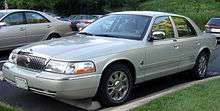 2005 Mercury Grand Marquis (30th Anniversary Edition) | |
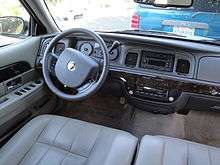 View of front seats and dashboard, 2011 Mercury Grand Marquis LS Ultimate Edition | |
| Overview | |
| Also called |
Ford Grand Marquis (Mexico) Grand Marquis by Ford (Canada) |
| Production | 2002-January 4, 2011 |
| Model years | 2003–2011 |
| Assembly | Canada: St. Thomas, Ontario (St. Thomas Assembly) |
| Body and chassis | |
| Body style | 4-door sedan |
| Related |
Mercury Marauder Ford Crown Victoria Ford Police Interceptor Lincoln Town Car |
| Powertrain | |
| Engine | 4.6 L Modular V8 |
| Transmission |
4-speed 4R70W automatic(2003–2005) 4-speed 4R75E automatic (2006–2011) |
| Dimensions | |
| Wheelbase |
2003–2008: 114.7 in (2,913 mm) 2009–2011: 114.6 in (2,911 mm) 120.7 in (3,066 mm)(Long wheelbase) |
| Length |
211.9 in (5,382 mm) (1998–2005) 212.0 in (5,385 mm) (2006–2011) 220.0 in (5,588 mm)(Long wheelbase) |
| Width |
78.2 in (1,986 mm) (1998–2008) 78.3 in (1,989 mm) (2009–2011) |
| Height |
56.8 in (1,443 mm) (1998–2008) 56.3 in (1,430 mm) (2009–2011) |
| Curb weight | 4,118–4,137 pounds (1,868–1,877 kg) |
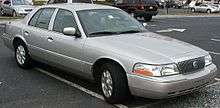
.jpg)
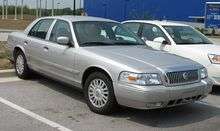
_in_2006_Washington_Auto_Show.jpg)
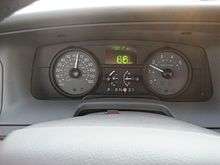
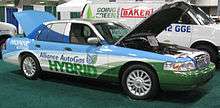
For 2003, the Grand Marquis saw an extensive styling update. However, many of the changes were under the skin, as the underpinnings of the Ford Panther chassis underwent its first complete redesign since its introduction for 1979. Alongside the Grand Marquis, Mercury would introduce two other full-size sedans, the 2003-2004 Mercury Marauder and the 2005-2007 Mercury Montego (which re-introduced the Mercury Sable nameplate for 2008-2009). In addition, the Grand Marquis largely replaced the Ford Crown Victoria in retail markets as it was discontinued from retail sale for the 2008 model year.
In 2010, the Grand Marquis marked 35 years of production, overtaking the Cougar as the longest-produced nameplate sold by the Mercury brand. In September 2010, after a short production run, the final versions for retail sale were produced. Slated to end production in December 2010, the production of fleet models was extended due to a parts shortage at the St. Thomas, Ontario factory. On January 4, 2011, the last Grand Marquis was produced in St. Thomas; it was the very last Mercury produced by Ford.
Chassis
While styling changes to the 2003 Grand Marquis were evolutionary, the changes to the Panther platform were far more extensive. To improve chassis rigidity, an all-new frame was introduced with fully boxed and hydroformed frame rails. In an effort to improve handling, the front and rear suspension were redesigned along with the brakes. A quiet EBD brake booster with a mechanical panic assist system was added. The new suspension changes required changing wheel designs to those with a high positive offset. Rack and pinion steering replaced the old recirculating ball system in an effort to increase steering precision and reduce costs. In standard versions of the Grand Marquis, the rear-axle ratio was 2.73:1; in LSE and versions with the handling suspension, a 3.27:1 rear-axle ratio was used. The handling package was standard equipment on LS-trim export models.
For 2008, the Handling and Performance Package as well as the 5-passenger front bucket-seat option were both discontinued; both were similar to the Crown Victoria's LX Premium Sport and Handling Package. These were the only post-1992 Grand Marquis variants produced for North America to be equipped with dual exhaust.
For the 2003 model year, the Grand Marquis retained the version of the Modular V8 introduced in 2001. Single-exhaust versions produced 220 hp, while the dual-exhaust version raised output to 235 hp. During the redesign, a number of changes were made to the engine. The oil pan was enlarged 20% to six quarts and an engine knock sensor was made standard. Other changes included an intake manifold with aluminum water crossover and an electronic returnless fuel system. The new engine was distinguished by a redesigned engine cover, featuring a chrome "V8" emblem; the oil filler cap was moved to the passenger-side valve cover and the power steering fluid reservoir was moved off of the engine block onto the radiator shroud. For 2006, revisions to engine tuning added 4 hp to both versions of the Modular V8, for a total of 224 and 239 hp, respectively. In 2007, the engine was given flex-fuel capability (E85). After the 2007 model year, the 239 hp version of the Grand Marquis was sold exclusively for GCC export.
All versions of the Grand Marquis were sold with variants of the AOD 4-speed overdrive automatic transmission. From 2003 to 2005, the 4R70W was used. In 2006, it was replaced by the 4R75E shared with the Ford truck lineup.[5]
| Engine Name | Years Available | Configuration | Horsepower | Torque | Transmission |
|---|---|---|---|---|---|
| Ford Modular V8 | 2003-2011 | 4.6 L (281 cu in) SOHC 16-valve V8 |
|
|
Ford 4R70W 4-speed overdrive automatic (2003-2005)
Ford 4R75E 4-speed overdrive automatic (2006-2011) |
Exterior
As part of the redesign, Lincoln-Mercury stylists were tasked with giving the Grand Marquis a more contemporary look, bringing it in line with other Mercury-division vehicles. While largely evolutionary, a number of changes modernized the exterior. In a change similar to the 2003 Town Car redesign, the heavily rounded bumpers seen on the Grand Marquis since 1992 gave way to a squared-off lower look. The art-deco trunk and taillight trim was simplified with more contemporary badging. In the front, to improve cooling, a larger grille introduced the Grand Marquis to the Mercury waterfall-style grille trim. Grand Marquis LS Limited Editions were equipped with a hood ornament, seen for the first time since 1991; the option also marked the return of factory-produced two-tone paint. To ease production, the Grand Marquis adopted body-color trim for the B-pillars, similar to the Crown Victoria.
In 2005, for a single year, the radio antenna became externally mounted, to the rear fender. After years of declining popularity, chrome wire wheel covers are available as an option from the factory for the last time.
For 2006, the Grand Marquis was given a mid-cycle exterior update, in what would be the last styling update for the Panther vehicles. The trapezoidal grille seen since 1995 was replaced by a rectangular one with a waterfall pattern similar to the Montego; the headlight clusters no longer extended to the sides of the grille, in a fashion similar to the 1988-1991 Grand Marquis. A redesign of the lower bumper allowed the addition of foglights as an option for the first time. In the rear, the trunk trim was changed from red to gray.
Interior
While not as extensive as changes to the exterior or chassis, Mercury made a number of changes to update the interior of the Grand Marquis in its 2003 redesign. Updated door panels and redesigned switchgear improved interior ergonmics, while the dashboard from 1995 remained in place. A dual media (cassette/CD) player made standard along with a valet key.[5] In the interest of safety, and to keep up with other Ford Motor Company vehicles, a shoulder belt was added for the rear middle passenger and side airbags were introduced as an option.[5]
In 2005, due to several mechanical modifications, several changes are made.[5] The steering column is replaced with a non-locking design; a flat-top steering wheel replaces the round-top version used since 1998. A fully electronic throttle moves the cruise control function into the main engine computer. For the front seats, occupant weight sensors were added, which allowed the front passenger airbag to be disabled. An Audiophile 6-disc in-dash CD changer became available as an option on LS-trim models.In 2005, an Audiophile sound system with a 6-disc in-dash CD changer became available to LS models.
For 2006, another major change was made as the instrument panel on all Panther-platform cars was redesigned; the optional digital instrument panel was discontinued, as was the use of an analog odometer. While the oil pressure and voltage gauges were removed, a notable addition was a tachometer; the Grand Marquis was one of the very last Ford vehicles sold without one. Similar to other Ford vehicles, the new instrument panel features a Driver Information Center (trip computer), consolidating many functions previously seen in the overhead console in between the speedometer and tachometer.
In 2007, an auto-dimming rearview mirror was added as an option, along with a full-size spare tire (making its return).
In 2009, due to federal regulations, side airbags became standard equipment along with recessed window switches.
Trim
As part of the redesign, Mercury would change the Grand Marquis trim lineup for 2003. In place of the traditional two-model line, the Grand Marquis was expanded to five. In addition to the base-trim GS, there was now GS Convenience, LS Premium, LS Ultimate, and LSE. Introduced at the Chicago Auto Show in February 2001, and in showrooms by May, the LSE was designated as the LS Premium with a heavy-duty rear suspension, shorter rear-axle ratio, and a 239-hp dual-exhaust engine; it offered 5-passenger seating with leather, dual power bucket seats, with a center console and floor shifter. The 2003 LSE was short-lived, as its production ended in December 2002; it made a brief return for 2005.
From 2003 to 2005 a "Limited Edition" version of the LS model was sold. The Limited Edition included an appearance package that featured chromed mirrors, body colored door handles, and a two-tone leather interior. Limited Edition models also came with side airbags standard. They are most notable for their use of the Mercury badge as a hood ornament, making its return for the first time since 1991.
For 2007 LS models, a ''Palm Beach'' trim option was available; it consisted primarily of special upholstery and badging.
For 2009, following the introduction of a "No-Stock" rule by Lincoln-Mercury, the Grand Marquis trim line underwent a revision. Aside from long-wheelbase GCC export models, the GS was dropped, while the LS was split into two series: ''LS Fleet'' and ''LS Retail''. The former was available exclusively for fleet purchase in the United States while the latter was available only by dealer special order; to minimize inventory, incentives as high as $4000 per vehicle were added to remove previous stock from dealer lots.
As Ford had announced the discontinuation of the Mercury brand in the summer of 2010, all 2011 examples are Mercury Grand Marquis LS Ultimate Editions.
Sales
| Year | 2003 | 2004 | 2005 | 2006 | 2007 | 2008 | 2009 | 2010[15] | 2011[16] | Total Production |
|---|---|---|---|---|---|---|---|---|---|---|
| Units | 92,140 | 87,583 | 66,133 | 54,688 | 50,664 | 29,766 | 24,783 | 28,543 | 248 | 434,548 |
Discontinuation
On June 2, 2010, Ford announced that it would end production of all Mercury vehicles by the end of 2010 as it discontinued the brand after 72 years. As a result of an unplanned delay in parts shipments, the final Grand Marquis was produced on January 4, 2011 at 7:46 am.[1] The St. Thomas Assembly plant in Ontario, Canada closed in September 2011, bringing an end to the production of the Ford Crown Victoria and Lincoln Town Car.
In continuous production for 36 years, the Grand Marquis was the longest-produced Mercury. In total, nearly 2.7 million were produced, making it the best-selling vehicle sold by the brand.[17] Among Ford Motor Company models in North America, only the Ford Econoline, Ford Mustang, Ford Thunderbird, Ford F-Series, and Lincoln Continental nameplates have been produced longer. The Panther platform served as the basis for Grand Marquis design for 32 years. Nearly unmatched by other automakers for longevity, the external appearance of the Grand Marquis remained largely unchanged for the last 19 years of its production life (along with its engine, the 2011 model shared a number of body panels with its 1992 counterpart).
| Year | 1983-1991 | 1992–1997 | 1998–2002 | 2003–2011 | Total production |
|---|---|---|---|---|---|
| Units | 987,818 | 688,107 | 606,206 | 434,548 | 2,716,679 |
Export markets
During its production, the Grand Marquis was sold throughout North America, although it was not always badged as a Mercury. Outside of North America, exports were concentrated on the Middle Eastern market, where its large size and V8 power were attributes still sought by buyers towards the end of production.
Canada
In Canada, the Mercury brand was phased out in 2004. After the demise of its short-lived Mercury Marauder twin in 2004, the Grand Marquis was the last remaining Mercury vehicle sold in Canada. The Grand Marquis replaced the civilian version of the Crown Victoria, which was now sold exclusively to commercial fleets and law enforcement in Canada (as a Police Interceptor). Sales continued until the 2011 model year, when the Ford Taurus became the next full-size Ford.
Mexico
In Mexico, the Mercury Grand Marquis was sold twice, replacing the Ford LTD Crown Victoria two-door and four-door (sold alongside the Ford Country Squire station wagon). Introduced in 1982, the Grand Marquis was sold until 1984, after which it was replaced by a Ford version of the Cougar; at the time, Mexico had banned the sales of vehicles with 8-cylinder engines.
Following its 1992 redesign, the Grand Marquis made its return to Mexico, again as the flagship of the Ford model line. From 1992 to 1994 it was manufactured in Mexico., after which it was imported from St. Thomas, Ontario, Canada. Wearing both Ford and Mercury badging, the Grand Marquis adapted a Ford Blue Oval on the trunklid after 1998.
Although the Grand Marquis was considered a sales success and developed a reputation for luxury and prestige as the most expensive domestic nameplate available for sale, as in the United States, sales began to decline as the model aged. For the 2005 model year, the Grand Marquis was replaced in the Ford line in Mexico by the Ford Five Hundred and the Mercury Montego, which were sold to 2007.
Middle East (GCC)
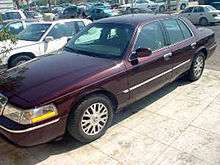
The Grand Marquis and its Ford Crown Victoria counterpart were popular sedans in the Middle East, especially in Kuwait and Saudi Arabia. Vehicles manufactured for this market were known as GCC Spec vehicles, available in all Gulf Cooperation Council (GCC) countries. For large car buyers, the Grand Marquis was popular due to its simplicity, reliability and affordability. However, as a result of its age, toward the end of its production life, the export version of the Grand Marquis began to lose market share towards rivals such as the Chevrolet Caprice (imported from Australia) and the Dodge Charger.
Modification
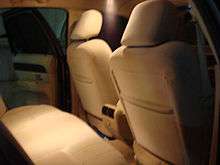
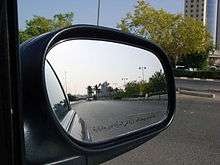
All vehicles destined for Middle East export feature the High Ambient Temperature and Speed Package, true dual exhaust (except for the long-wheelbase GSL), a heavy-duty battery, and an auxiliary transmission fluid cooler. In addition, the language of warning labels are in Arabic instead of English (see picture). Since 1998, the GCC-spec Grand Marquis has shared its 40/20/40 front seats with the Lincoln Town Car (as opposed to the 50/50 split-bench of the Crown Victoria/Grand Marquis); due to the warm climate, cloth seats are standard equipment (with leather as an option). Vehicles manufactured prior to 2002 also featured a catalytic converter delete option.
As a handling upgrade, the GCC-spec Grand Marquis was available with an Export Handling Package option. Similar to its North American counterpart, it consisted of rear air suspension, stiffer springs, larger front stabilizer bar, and a heavy-duty rear stabilizer bar. Unlike its American counterpart, it shared the stock rear-axle ratio (3.08 before 2002 and 2.73 from 2003 to 2011). The Export Handling Package was available on any standard-wheelbase GCC-spec Grand Marquis and standard on all LS-trim versions; models with the Handling Package featured a rear Mercury Marauder trunklid spoiler and 16" 9-spoke Crown Victoria LX wheels (with Mercury center caps). The LS Premium and LS Ultimate models equipped with the handling package share the same 16" 9-spoke wheels as their LS counterparts. The 9-spoke Crown Victoria LX wheel (with a Mercury center cap) replaced the 2003–2005 LSE wheels with darker inserts for 2006 and 2007.
Trim variation

Middle Eastern versions of the Grand Marquis are equipped with slightly different options and features than their North American counterparts. Prior to 2009, six different trim levels were available:
- GS
- GS Convenience
- GSL
- LS (LSE limited to mid-2001 to mid-2003 and 2005 model year)
- LS Premium
- LS Ultimate.
In 2009, the LS models were only available with a column shifter and 40/20/40 Lincoln Town Car seats, available in luxury cloth or leather trim. The GSL is a long-wheelbase model offering 152 millimetres (6.0 in) of extra leg room for rear passengers. It is equipped like an LS model, with standard features such as an 8-way power driver's seat (2 way manual passenger seat), side airbags, leather-wrapped steering wheel, automatically dimming rearview mirror, electronic climate control, power-adjustable pedals, premium sound system with CD and cassette, 17-inch wheels with 235/55WR17 Goodyear Eagle RS-A tires, heated door mirrors, fog lights and special "GSL" badging. The once-optional gauge cluster is standard, with controls located on the centre of the dashboard, between the headunit and climate controls. In North America, this model was only available to fleet customers as a commercial (taxi) version of the Ford Crown Victoria.
For 2009, the Grand Marquis was only available in two different trim levels: GSL and LS, both of which were near identical in terms of features and options. The LS was a Fleet model, which was heavily de-contented, losing once-standard features such as an overhead console with compass and a power passenger seat. The Export Handling Package was dropped, elimining features such as the Mercury Marauder spoiler and rear air suspension. In Kuwait, the 2009 GSL retailed for KWD 6,500 ($22,000) and a fully equipped LS for KWD 7,500 ($25,425).
For 2010, the GS model reappeared in the line up, and several features (such as the Mercury Marauder spoiler) became available as standalone options. The Export Handling Package was made standard along with a power passenger seat. In Kuwait, the LS model (M7F) was not available to the general public in 2010, as they are heavily sold to fleet buyers, such as the Ministry of Defense, Ministry of Interior, Ministry of Health and state-owned Kuwait Oil Company, where they are given to employees as fringe benefits.
For 2011, the long wheelbase GSL was replaced by the GS, and the LS model was made available again to the general public in Kuwait. The LS Ultimate Edition remains a Fleet model and differs only slightly from the GS, equipped with features such as leather seats, Electronic Automatic Temperature Control (EATC) and an automatically dimming rear-view mirror. Lumbar support was no longer available.
References
- 1 2 "Mercury rolls into history with build of final Grand Marquis". AutoWeek. 2011-01-04.
- ↑ Odin, L.C. A concise guide to the Ford and Mercury full-size automobile production 1969-1978. Belvedere Publishing, 2016. ASIN: B01HE91Y4K.
- 1 2 3 4 5 "The Complete "Box" Panther History". Retrieved 15 April 2014.
- 1 2 3 "Box Panther Production Numbers". Retrieved 5 February 2014.
- 1 2 3 4 5 6 7 8 9 10 "Liquid's Model Year Changes". Retrieved 2007-12-10.
- 1 2 http://www.automobile-catalog.com/car/1983/1885520/mercury_grand_marquis_4-door_sedan.html
- 1 2 http://www.automobile-catalog.com/car/1984/1886780/mercury_grand_marquis_4-door.html
- 1 2 http://www.automobile-catalog.com/car/1984/1886870/mercury_grand_marquis_4-door.html
- 1 2 http://www.automobile-catalog.com/car/1986/1889000/mercury_grand_marquis_4-door.html
- ↑ http://www.automobile-catalog.com/car/1986/1889015/mercury_grand_marquis_4-door_5_8l_v-8_ho.html
- 1 2 3 Popular Mechanics-Automobiles-New Cars-Ford Revitalizes Big Car Lineup. 1991.
- ↑ Rules of origin issues related to NAFTA and the North American automotive industry: report to the Committee on Ways and Means, U.S. House of Representatives, on investigation no. 332-314 under section 332 of the Tariff Act of 1930. U.S. International Trade Commission. 1991. p. 47.
- 1 2 3 The Encyclopedia of American Cars, 2006 Edition
- ↑ Leonard M. Apcar (28 September 1997). "BEHIND THE WHEEL/Mercury Grand Marquis; Rear Drive but Refusing to Retire: A Case of Modern Maturity". New York Times.
- ↑ "Ford Motor Company December 2010 US Sales" (PDF). Archived from the original (PDF) on November 7, 2012. Retrieved 27 April 2014.
- ↑ "Ford Motor Company December 2011 US Sales" (PDF). Archived from the original (PDF) on May 22, 2012. Retrieved 27 April 2014.
- ↑ "Mercury History" (PDF). Ford Motor Company. Archived from the original (PDF) on August 21, 2011. Retrieved 13 February 2015.
External links
| Wikimedia Commons has media related to Mercury Grand Marquis. |
| « previous — Mercury passenger vehicle timeline, 1980–2011 | |||||||||||||||||||||||||||||||||
|---|---|---|---|---|---|---|---|---|---|---|---|---|---|---|---|---|---|---|---|---|---|---|---|---|---|---|---|---|---|---|---|---|---|
| Type | 1980s | 1990s | 2000s | 2010s | |||||||||||||||||||||||||||||
| 0 | 1 | 2 | 3 | 4 | 5 | 6 | 7 | 8 | 9 | 0 | 1 | 2 | 3 | 4 | 5 | 6 | 7 | 8 | 9 | 0 | 1 | 2 | 3 | 4 | 5 | 6 | 7 | 8 | 9 | 0 | 1 | ||
| Coupe | |||||||||||||||||||||||||||||||||
| Sport compact | Capri | Capri | Cougar | ||||||||||||||||||||||||||||||
| LN7 | |||||||||||||||||||||||||||||||||
| Personal luxury | Cougar | Cougar | Cougar | ||||||||||||||||||||||||||||||
| Sedan | Subcompact | Bobcat | Lynx | Tracer | |||||||||||||||||||||||||||||
| Compact | Tracer | Tracer | |||||||||||||||||||||||||||||||
| Zephyr | Topaz | Topaz | Mystique | ||||||||||||||||||||||||||||||
| Monarch | |||||||||||||||||||||||||||||||||
| Mid-size | Cougar | Marquis | Sable | Sable | Sable | Sable | Milan | ||||||||||||||||||||||||||
| Full-size | Marquis | Marauder | Montego | Sable | |||||||||||||||||||||||||||||
| Grand Marquis | Grand Marquis | Grand Marquis | Grand Marquis | ||||||||||||||||||||||||||||||
| Station Wagon | Subcompact | Bobcat | Lynx | Tracer | |||||||||||||||||||||||||||||
| Compact | Zephyr | Tracer | Tracer | ||||||||||||||||||||||||||||||
| Mid-size | Cougar | Marquis | Sable | Sable | Sable | Sable | |||||||||||||||||||||||||||
| Full-size | Colony Park | ||||||||||||||||||||||||||||||||
| Light truck | |||||||||||||||||||||||||||||||||
| SUV | Mariner | Mariner | |||||||||||||||||||||||||||||||
| Mountaineer | Mountaineer | Mountaineer | |||||||||||||||||||||||||||||||
| Minivan | Villager | Villager | Monterey | ||||||||||||||||||||||||||||||